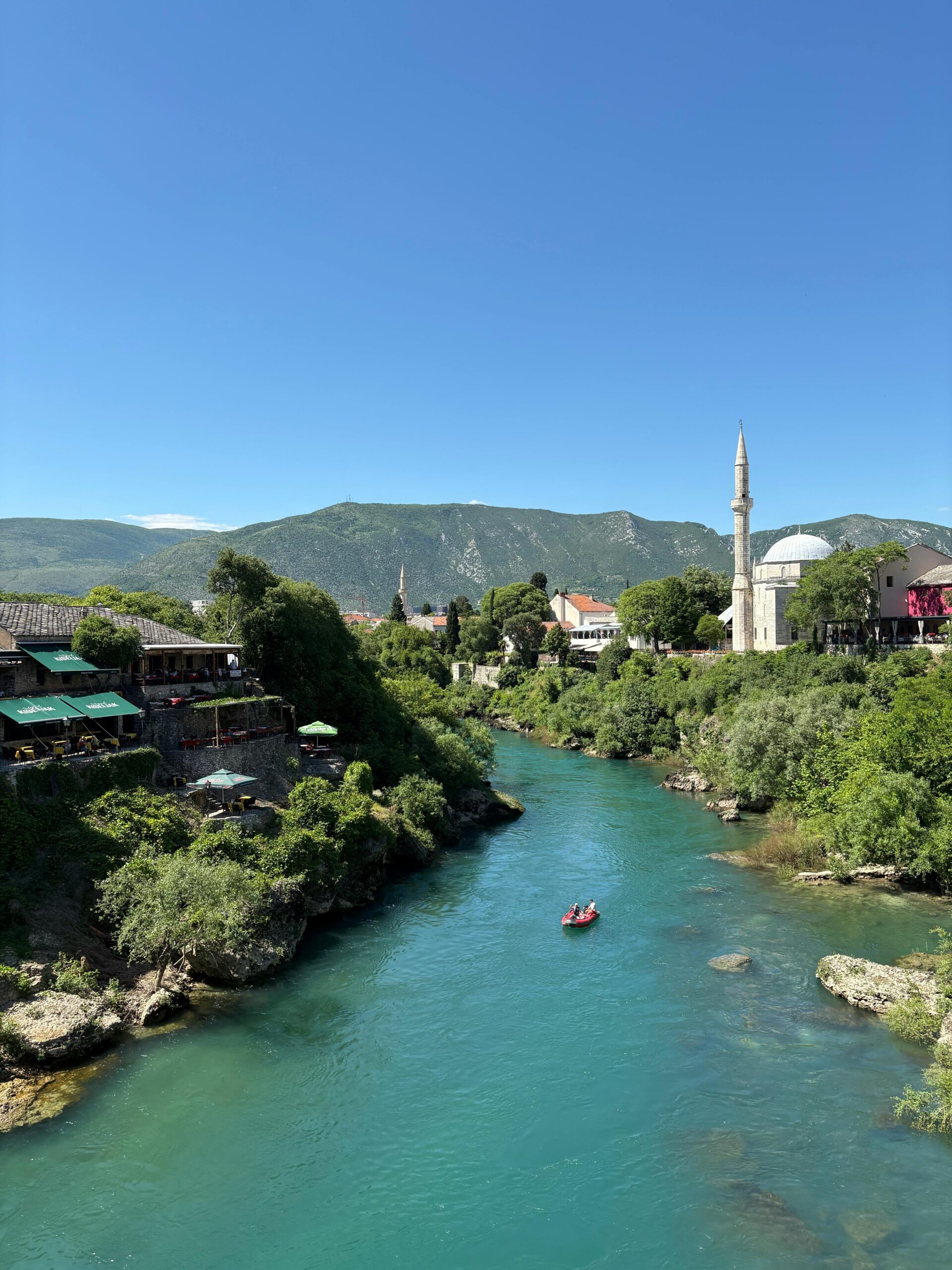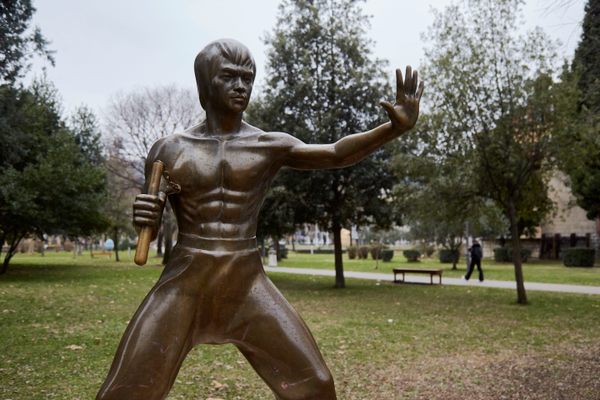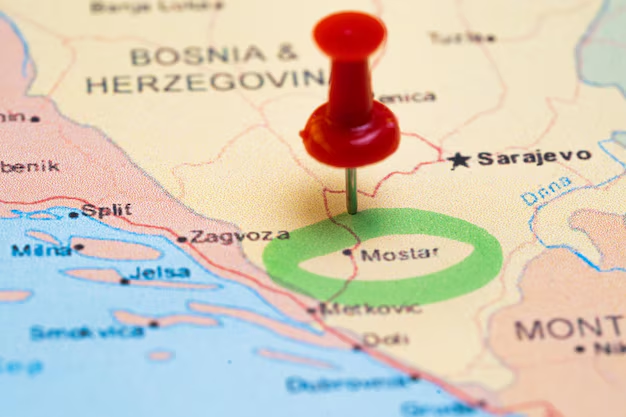A Martial Arts Icon in an Unexpected Place
In the heart of Mostar, Bosnia and Herzegovina, stands one of the world’s most unexpected monuments: a life-sized bronze statue of martial arts legend Bruce Lee. At first glance, this might seem peculiar: what connection could Bruce Lee possibly have to this Balkan city? The answer reveals a profound story of cultural unity, post-war reconciliation, and the universal appeal of an iconic figure who transcended ethnic divisions in a deeply fractured region.
This comprehensive guide explores Mostar’s Bruce Lee statue’s fascinating history, cultural significance, and ongoing legacy. This monument represents far more than just a tribute to a martial arts star.
The Historical Context: War and Division in Mostar
The Bosnian War and Its Impact on Mostar
To understand the significance of the Bruce Lee statue, we must first understand Mostar’s recent history. In 1992, Bosnia and Herzegovina declared independence from Yugoslavia, triggering intense ethnic tensions that erupted into violence. The city of Mostar became a focal point of the conflict, with the Neretva River serving as a dividing line between the predominantly Croat western side and the predominantly Bosniak eastern side.
The war devastated Mostar both physically and socially. The iconic Old Bridge (Stari Most), a 16th-century Ottoman structure and symbol of the city, was destroyed in November 1993. By the time the war ended in 1994, approximately 2,000 people had died in Mostar alone, and the city’s multicultural fabric had been torn apart.

Post-War Divisions
Even after the Dayton Peace Agreement ended the war in 1995, Mostar remained a divided city. The physical reconstruction of the Old Bridge in 2004 (which has since become a UNESCO World Heritage site) was an important symbolic step, but the social divisions remained deeply entrenched. The city continued to function with parallel institutions, separate schools, and minimal interaction between ethnic groups.
It was in this context of persistent division that a group of local youth decided to take action to promote unity through an unexpected symbol.
The Birth of an Idea: Urban Movement Mostar
A Youth Initiative for Unity
In 2004, a youth group called Urban Movement Mostar conceived an ambitious idea: to create a monument that could serve as a unifying symbol for all citizens of Mostar, regardless of their ethnic background. The group, led by Nino Raspudić, Veselin Gatalo, and other young activists, wanted to find a figure who could transcend the ethnic divisions that had torn their city apart.
Finding a Universal Symbol
The group considered various potential figures for their monument, including Mahatma Gandhi and Pope John Paul II. However, they needed someone who would be universally accepted by all ethnic groups in the city, Croats, Bosniaks, and Serbs alike.
When Urban Movement Mostar conducted informal polls among local residents, one name consistently emerged as a figure respected across ethnic lines: Bruce Lee. As Veselin Gatalo, a representative of the group, famously stated: “We will always be Muslims, Serbs or Croats… But one thing we all have in common is Bruce Lee.”
Why Bruce Lee? The Cultural Phenomenon
Bruce Lee’s Popularity in Yugoslavia
Bruce Lee’s popularity in the former Yugoslavia was extraordinary. During the 1970s and 1980s, his films became cultural phenomena throughout the region. There was a thriving black market for VHS tapes of his movies, and his philosophy of self-improvement and personal strength resonated deeply with people across all ethnic backgrounds.
A Symbol Beyond Ethnicity
What made Bruce Lee particularly suitable as a unifying symbol was that he represented values that transcended ethnic divisions:
- Universal appeal: His films were enjoyed by people of all backgrounds
- Strength and justice: He fought against oppression and for the underdog
- Cultural bridge: As a person who bridged Eastern and Western cultures
- Non-political nature: He had no connection to local political conflicts
As Nino Raspudić, Croatian philosopher, explained, “Bruce Lee is a true international hero and is a hero to all ethnicities in Bosnia, and that’s why we picked him to be a symbol of our city.”
The Statue’s Creation and Unveiling
Design and Funding
The statue was designed by Croatian sculptor Ivan Fijolić. Interestingly, the project received financial support from the German government as part of post-war reconciliation efforts. Additional funding came from Chinese businesses operating in Bosnia and Herzegovina, who were eager to support a monument to one of China’s most famous cultural exports.
The life-sized bronze statue depicts Bruce Lee in his classic fighting stance from the film “Enter the Dragon,” ready for action with his nunchaku.
The Grand Unveiling
On November 26, 2005, the Bruce Lee statue was unveiled in Zrinjevac Park in Mostar. The ceremony attracted around 300 people, including local citizens from all ethnic backgrounds, officials, martial arts enthusiasts, and a delegation of Chinese businesspeople.
The unveiling was a festive occasion featuring kung fu demonstrations and speeches about unity and reconciliation. It was hailed as an important symbolic moment for the divided city—the first monument erected in Mostar since the end of the war that wasn’t dedicated to a military or religious figure.

Controversy and Vandalism
Initial Reactions
Despite the positive intentions behind the statue, it wasn’t without controversy. Shortly after its unveiling, the statue was vandalized. Some reports suggested that certain groups were unhappy with the direction Bruce Lee was facing, interpreting his combat stance as aggressive and directed toward “their” side of the city.
Relocation and Restoration
Following the vandalism, the statue was removed for repairs. When it was reinstalled, it was placed in a different location in the park and positioned to face north, a neutral direction that wouldn’t be interpreted as pointing toward either the eastern or western part of the city.
The statue was subsequently vandalized several more times over the years, reflecting the ongoing tensions in the city despite efforts at reconciliation.
The Statue Today: A Tourist Attraction and Symbol
Cultural Impact
Over the years, the Bruce Lee statue has become one of Mostar’s unique tourist attractions. Visitors from around the world come to take photos with this unusual monument and learn about its symbolic significance.
The statue has been featured in international media, travel guides, and documentaries about Bosnia and Herzegovina, helping to tell the story of Mostar’s efforts at post-conflict reconciliation.
The 2024 Theft
In a shocking development, the Bruce Lee statue was stolen in March 2024. Local authorities launched an investigation, but as of the time of this writing, the statue has not been recovered. The theft sparked outrage among local residents and Bruce Lee fans worldwide, with many calling for its immediate return or replacement.
The disappearance of the statue has, ironically, once again united citizens of Mostar in their shared dismay at losing this important symbol of unity.
Similar Unity Monuments Worldwide
Mostar’s Bruce Lee statue is not the only monument dedicated to bringing people together across divides. Other notable examples include:
The Peace Walls in Belfast
In Northern Ireland, several murals and art installations along the “peace walls” serve as symbols of reconciliation between Protestant and Catholic communities.
The Reconciliation Statue in Coventry, UK
This bronze statue depicts a man and woman embracing across the ruins of the old Coventry Cathedral, symbolizing forgiveness and reconciliation after World War II.
The Statue of Brotherhood and Unity in North Macedonia
This monument in Skopje was designed to represent the unity of Macedonia’s diverse ethnic groups.
Visiting the Bruce Lee Statue Location
How to Get There
The Bruce Lee statue was located in Zrinjevac Park in the western part of Mostar. The park is within walking distance of the city center and approximately 1.5 kilometers from the famous Old Bridge.
Address: Zrinjevac Park, Mostar 88000, Bosnia and Herzegovina
Coordinates: 43.3438° N, 17.8078° E

Nearby Attractions
While visiting the statue’s location, consider exploring these nearby attractions:
- The Old Bridge (Stari Most) – The iconic 16th-century Ottoman bridge, reconstructed after the war
- Old Bazaar (Kujundžiluk) – Traditional crafts and souvenirs in the old town
- Koski Mehmed Pasha Mosque – Offers panoramic views of the city from its minaret
- War Photo Exhibition – Powerful photographs documenting the Bosnian War
- Crooked Bridge (Kriva Ćuprija) – A smaller, older bridge predating the famous Old Bridge
Accommodation Options
Several hotels and guesthouses are available near the park:
- Hotel Mostar – Mid-range hotel with good amenities
- Villa Anri – Boutique accommodation with local character
- Pansion Cardak – Budget-friendly option near the Old Town
The Legacy and Meaning of Mostar’s Bruce Lee
Symbol of Unity in Diversity
The Bruce Lee statue represents a powerful idea: that even in deeply divided societies, there can be cultural touchpoints that bring people together. It demonstrates how popular culture can sometimes succeed where political initiatives fail.
A Lesson in Reconciliation
The statue serves as a reminder that reconciliation often begins with finding common ground—sometimes in unexpected places. By celebrating a shared cultural icon, the people of Mostar found a small but significant way to begin healing the wounds of war.
The Power of Youth Initiatives
The success of Urban Movement Mostar in creating this monument highlights the important role that youth and grassroots organizations can play in post-conflict reconciliation. Their creative approach to addressing division offers lessons for other divided communities worldwide.
How You Can Help Preserve This Cultural Symbol
The theft of the Bruce Lee statue in 2024 has highlighted the need for community involvement in preserving this important cultural symbol. Here are ways you can help:
- Share information: If you have any information about the statue’s whereabouts, contact local authorities in Mostar
- Spread awareness: Share this story on social media to raise awareness about the statue’s significance
- Support replacement efforts: If initiatives arise to create a replacement statue, consider supporting them
- Visit Mostar: Tourism helps support the local economy and cultural preservation efforts
Conclusion: More Than Just a Statue
Mostar’s Bruce Lee statue is far more than just a quirky tourist attraction or an homage to a martial arts star. It represents a creative approach to reconciliation in a post-conflict society and demonstrates how cultural icons can transcend even the deepest societal divisions.
Whether the original statue is recovered or eventually replaced, its legacy as a symbol of unity in a divided city will endure. In a world where ethnic and religious tensions continue to cause conflict, the story of Mostar’s Bruce Lee offers a small but meaningful example of how common cultural ground can be found even in the most unlikely places.
Additional Resources
For those interested in learning more about Mostar, the Bruce Lee statue, and post-war reconciliation in Bosnia and Herzegovina, here are some valuable resources:
- Mostar Tourism Official Website
- UNESCO World Heritage: Old Bridge Area of the Old City of Mostar
- Post-Conflict Research Center Bosnia
- Bruce Lee Official Website
Have you visited the Bruce Lee statue in Mostar? Share your experience in the comments below! If you have photos from before the 2024 theft, we’d love to see them, please share them with us.



